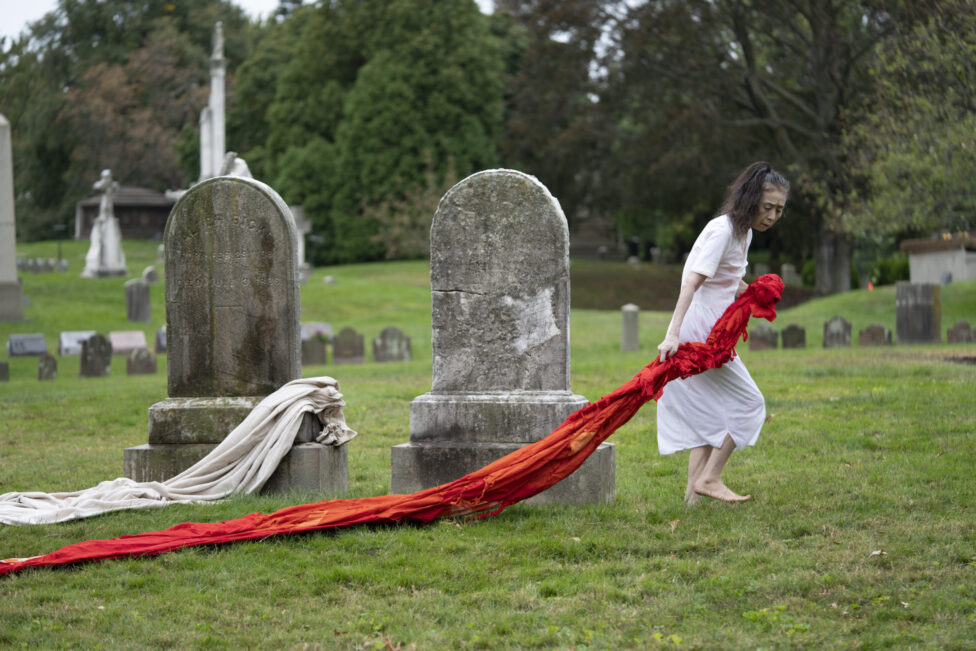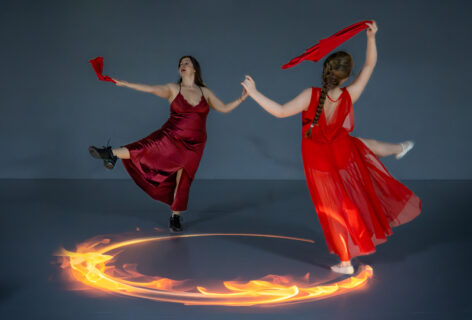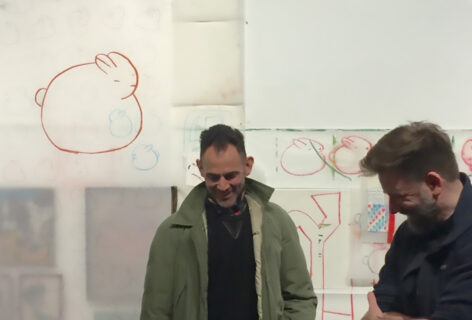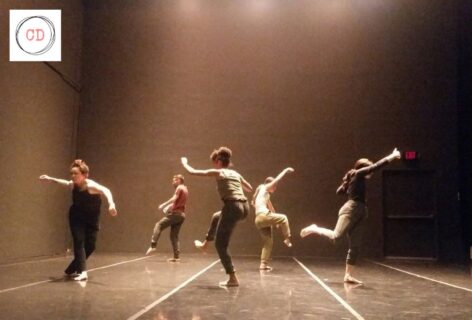A Body in a Cemetery
Eiko Otake: I first want to say this was not something I conceived. My solo work A Body in Places started with A Body in a Station at the 30th Street Station in Philadelphia. I didn’t come up with the idea of dancing in a majestic station—Harry Philbrick, the director of the Pennsylvania Academy of the Fine Arts, invited Eiko & Koma to perform there. I changed that to Eiko’s 12-hour solo performance over four Fridays in a station. This, along with my Fukushima work, was the beginning of my solo career at the age of 62. Since then, I have performed my solo work at 67 different sites. This excludes the places I performed without an audience in post-nuclear disaster Fukushima.
Allison Hsu: So before A Body in a Cemetery, what was the last performance you had of A Body in Places?
EO: I thought it was the Met performances in November 2017. But in looking back, I realize I had continued to perform solo on different occasions, including in Tokyo. But the Met event felt like some sort of conclusion because I performed for a total of twenty-two hours and thirty minutes over three Sundays. So just like how our week-long MoMA performance in 2013 made Koma and me seek something entirely new and I started performing solo, I planned to start my Duet Project after the Met performances. I actually left for the Rauschenberg Residency in Florida the next day after the Met’s final performance. Since then, I have been working with 20 collaborators creating different duets. The project was supposed to tour from this spring to next fall, but all were cancelled or postponed.
The invitation to perform in Green-Wood Cemetery came in November 2019 from Gabriel Florenz, the Founding Artistic Director of Pioneer Works. In November, I had a site visit and met Harry Weil, the Director of Public Programs at Green-Wood. It was then that I decided to perform in a cemetery. We had no idea that the pandemic was to come. But even then, I found the idea of performing among so many graves challenging. The performance was initially planned for July but had to be postponed. We knew if we cannot do this in September, it would soon be too cold and we would have to wait until the next summer.
Wanting to perform but not wanting to risk my or anyone’s health, I was indecisive for many weeks. As September approached, I began to feel a desire to offer an event for people to come see together in the same place. By then it became clear to me that if I was to perform in the cemetery during the pandemic, it would have to be a solo, because it’s a lot easier to develop a score and adapt to changes when you are working alone.
AH: How did you mentally and emotionally prepare for the performance?
EO: Since our site visit, I never stopped thinking about what it might feel like for me to perform in a cemetery. The meaning of the cemetery and graves are universal and timeless, but the ways the dead are placed in graves vary across cultures. In Japan where I grew up, most of the dead are cremated. Mourners pick up each bone with chopsticks and put them in an urn. The bones, not ashes, stay with living family members for 49 days and are then brought to a family grave. When we open the grave, the new urn joins the other urns of the deceased family members. In the pandemic, this personal sense of death is compromised, but the notion of the dead joining the layers of the past dead seems important.
In planning any performance of A Body in Places, I usually work with the function of the place and the particulars of the performance site—landscape, architecture, season, time, and who are expected to come why and how. Thinking in Japan about a cemetery in Brooklyn was not the same as working at the site. So I decided upon my return to the city, I would spend as many days and hours as possible in Green-Wood. I enjoy being a stranger, but I still want to be a host of the performance welcoming the audience members to the place where I’m performing. I also explored and danced in several other parts of the cemetery in order for me to know this place.
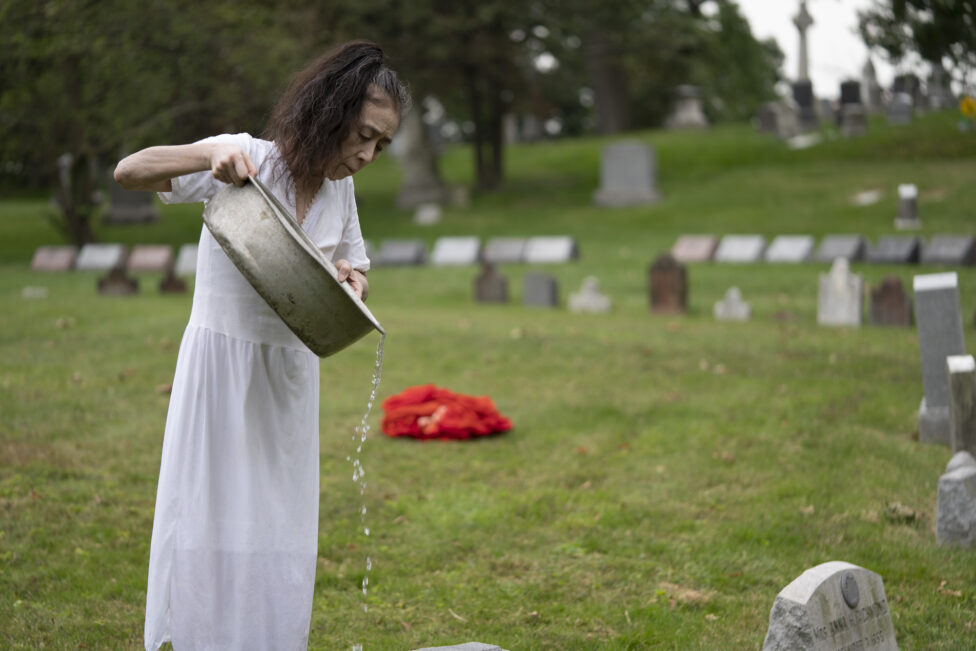
photo by William Johnston
ID: Eiko Otake in a white dress and long black hair in a ponytail, pouring water from a large metal basin in Green-wood Cemetery
I usually do solo work where people come pretty close to me. People follow me in different formations and when they’re crowded around me, I can cut into them, reversing the sight line. I usually try to look my audience members in the eye and even touch some of them. But that’s not possible in the pandemic. In choreographing, I kept imagining what the audience would see from a wide range of viewpoints and heights. My body is so small in that big space. Usually my solo performances have a quiet time and an accelerated time. Sometimes, I find a reason to add more staccato, sometimes even violent moves. But in the graveyard, I am surrounded by the dead. I needed to address this by dancing for them as well as my audience. Since the spring, the Black Lives Matter movement presented more openly historical and systematic injustice and violence. So being angry and upset became our everyday life. In the program note, I wrote that in coming here to rehearse and to perform, I made a point of leaving my upsets at the gate, promising myself to pick them up on my way home.
This means I had to ask myself everything twice, three or more times. Why am I doing this? Who am I? I am trying not to be defeated by a pandemic but I do not want to be too brave either. I wanted to find a way to physically be present in the history with empathy and a critical viewpoint. I wanted to put my living body quietly near the dead so as not to disturb them.
AH: You were very clear about how you didn’t want it to be a theatrical production or a spectacle, and the word “ritual” really encompasses what the performance ended up being. Because for so long, artists and audiences weren’t able to gather in theaters or in any spaces and that inhibits the way that we can experience grief and mourn collectively.
EO: A cemetery is a good place to do so. I asked them, “Are there new deaths?” Yes, with the pandemic, they have more bodies coming in. At the same time, it’s very historical, so our time is clearly joining historical time. While we were rehearsing there, we saw a few new graves being dug and flowers being placed. And then we see the priest come, the family comes. This is an active, working cemetery. Why would I think otherwise? New dead are placed among the older dead.
AH: When you were performing in all these sites around the city, say in Fulton Center or in the Wall Street, some of your audience wasn’t intentional. Some people came to see you, but other people were just walking through and didn’t even really know what was happening. But with this performance, everyone who’s there knew what was happening. Those familiar with your work knew what to expect, for the most part.
EO: Yes, when I was performing on Wall Street, there was an intentional audience and then there were passersby. They look at each other as if the others are aliens. But not in Green-Wood. By the time we are performing later in the day in that big space, most everyone was there intentionally. Many came with someone whom they had not seen for a long time.
AH: And that brings a sense of willingness, where everyone is there together and prepared to take part in the ritual that’s happening.
EO: I was actually quite stunned to find out the entire Danspace [Project] staff came to the show. I was told that this event was the first time they saw each other in person since March, I saw them and many friends at Okwui’s [Okpokwasili’s] show, which was the last performance before the pandemic cancelled many things. And I realized for those people, my performance was the first time they could be together again. Some time ago, people gathered in churches and temples. But my community met in theaters and performance spaces. If you take away performances, we don’t really see each other as a community. A place like Danspace was our community. I go there and see many people I know. We would talk before and after the show, sometimes you go out together. This is how we function as a part of our community. So now, months later, even though this was not in downtown New York, it kind of acted as that re-emergence of a community. People stayed there long after the performance ended before slowly walking back to the gate.
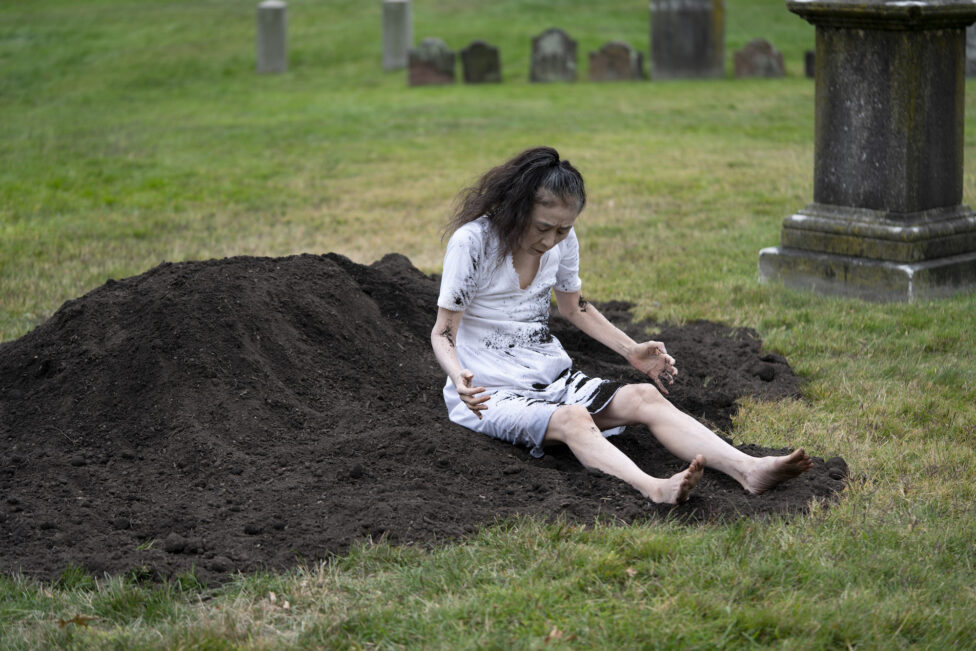
photo by William Johnston
ID: Eiko Otake is barefoot in a white dress sitting in a pile of earth that looks like it was recently dug up
AH: For me, it had a very different emotional resonance from the last performance I saw back in early March. It was an experimental theater performance in a big venue. When we talked about the virus then, we were still under the impression that it wasn’t going to be as serious as we now know it is. We thought that life would soon return to a sense of normalcy, and that’s obviously not the case. But going into that performance, I didn’t think about it at the time being the last performance I would see for the next half a year. Meanwhile, this time, while watching you, I was very aware that it would still be a long while before the next live performance.
EO: Yes for me too. So the first performance was like, “Oh, I haven’t performed in a very long time.” The second performance was, “Oh, I do not know when I can perform again..” It’s not going to be this way forever, but at my age, not knowing when next is a heavy thought.
AH: Also there was another side emotionally I saw with you when you were performing in the cemetery. You’re addressing grief and loss, but during rehearsals, I noticed you were invigorated by the idea of having an audience and being able to have a live performance for the first time in a long time, and so there was also that energy and liveliness there.
EO: Yes. I crave to perform. Though it was not easy, I was never regretful, I was actually quite grateful to perform for the dead.
I rehearsed many times. We measured how the sun and shadow moved and how soon the site got darker on a cloudy day. We shifted the performance time to be 30 minutes earlier because of this. Rehearsing in different weather made it so that I no longer relied on a particular condition…Yes, of course, I wished for the sun to be out, as I choreographed considering the setting sun and the moving shadows, but I was prepared to miss both. And even when it started to rain a bit, I was still kind of appreciating…The rain stopped soon, but even if it did not, I would have still continued. That’s one of the beautiful things about site-specific work and A Body in Places: through rehearsals, I begin to feel I belong to the place even though I have been with it for only a number of days. As a performer, I have visited many places and I have somehow made it as if I inhabited it at least for the time being. By the time an audience comes, I can welcome them.
AH: During the first performance, there was this moment when you first appeared where all of a sudden, all the mumbling in the audience stopped, and then the sun came out for like a brief second, almost like the house lights of a theater dimming, and it really felt like the performance was starting. It wasn’t intentional, but it really made it feel…nothing felt normal, right? We still knew the world that we were in. Everyone’s wearing masks. Everyone’s more than six feet apart. But it was a very collective moment of, “Oh, we’re back. We’re returning to live performance and we can experience it together again.”
EO: When the audience noticed me, there came a beautiful quietness. People said that all of a sudden they heard many birds. As I entered the space and walked for a long time, I said in a small voice, “Thank you for coming.” During the 8-minute walk to the front center of the performance area, I murmured in Japanese “ありがとう” and in English “Thank you.” Because I was so far away, I knew nobody could hear it, but it just helped me to be purposeful. It’s nice that we can thank each other. And I felt warmth from the audience for doing this. I thanked the cemetery and I thanked each audience member. When I saw a familiar face, I murmured “Oh, you came too! We’re doing this together.” Nobody heard me, but they perhaps sensed I was speaking.
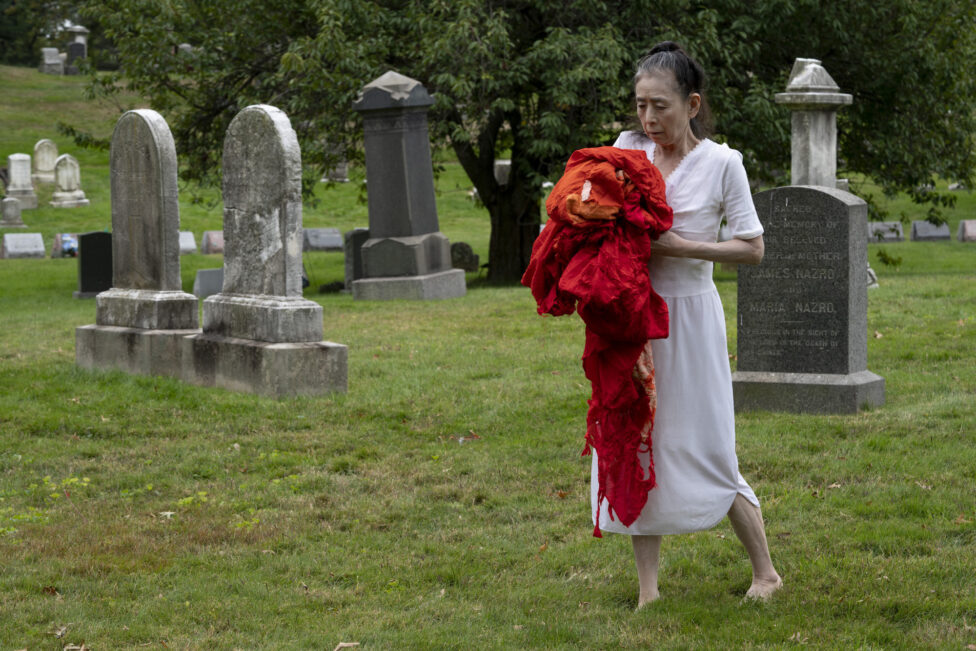
photo by William Johnston
ID: Eiko Otake in a white dress holding a large bundle of bright red fabric mid-step on the grass in front of two gravestones.
AH: And when you exited at the end of the performance, the audience thanked you in return.
EO: At the very end, I was not sure if I should walk away without a bow. It would be a clear ending of a cycle. I go back toward where I came from. But then I stopped and I bowed. Siobhan Burke wrote in her New York Times review that it was a relief to have the repeat of the ritual of a bow and applause. Audiences and I appreciate that ritual. I was very grateful, so I bowed. Slowly, we developed the piece up to that point.
AH: While you didn’t physically guide the audience through the cemetery in the performance, all of the audience members had to walk 20 minutes from the entrance, through the cemetery, and to the site. That really allowed them to familiarize themselves with the space and informed their individual experience of the performance.
EO: Here, history is absorbed in the landscape—I’m pretty sure there are people buried there who died on 9/11. There’ll be many different victims from different events, as well as the many people who have died of natural causes. And it’s very important for us to keep addressing people who don’t have a grave. It genuinely felt profound to do a live performance in the cemetery. There’s a sense you’re visiting somewhere significant rather than you’re just going to somewhere like the park. Each grave marks a life, and there are so many marks there. I like places that have substance, voices, and lingering shadows.
I knew for everyone, being in a cemetery in September 2020 was going to be memorable. I did not have to do much to get the audience’s attention, which I needed in a place like Wall Street. I offered a destination for their walk and a particular time that they could be together in the same place.
The change of light is dramatic. People appreciated that.
AH: You really feel the time when you’re sitting there. The leaves are falling right on top of you if you’re sitting near one of the trees and you see the sun moving. You asked me to record a video of the site, to record how the sun and shadows moved on a sunny day.
EO: It was very helpful. I watched the video imagining my body there. I noticed the tree outside of the performing area was where the sun stayed the longest. So I went to the tree and danced my tree dance as the last scene before I began retreating. Then “upstage,” the sun is there the longest where I bow. I would barely make it there before the whole area becomes a shadow. So walking slowly but not making it any slower, I felt the rush in my mind. That gave me good tension. I followed the rush but also resisted.
AH: Is that the same process you’ve done with all of the previous sites you’ve performed at? Do you think that carefully about where the sun is and where it’s moving?
EO: Yes, to a degree. Less so when the audience can move around. Planning this performance was more particular because of the need for social distancing. I had to secure their sightlines while keeping them far from each other. The only solution was to accept that they sit far from each other and not change their placement. Unlike my performances at other public sites, people bought tickets and came to stay to see until the end. To witness time changing together at the end of the day, at the end of the summer, in the time of the pandemic, there was a sense of human desire and commitment.
I decided to perform to the east with audiences facing west. Once I chose that way, all of a sudden, these two grave markers came into a focus. I don’t know if you had the chance to read the story I sent you…
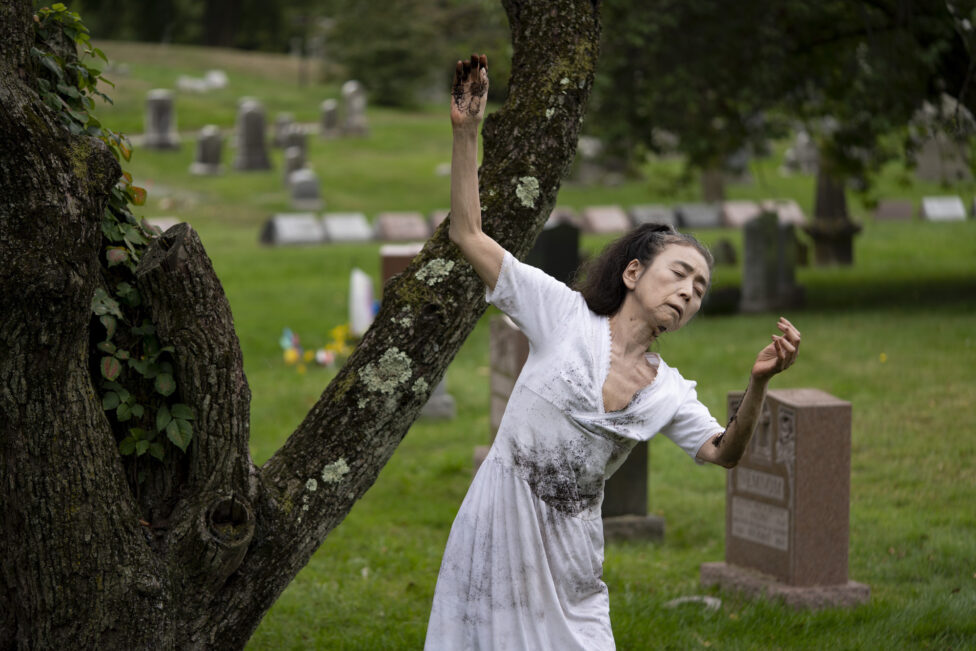
photo by William Johnston
ID: Eiko Otake in a dirt-stained white dress with arms slightly bent overhead and leaning to the right with her eyes closed.
AH: Oh yeah, “Two Grave Markers” by Kyoko Hayashi.
EO: Yeah, it’s a pretty hard story about two girls during and after the Nagasaki atomic bombing. One girl leaves her friend to die alone but she too dies soon after being tormented by guilt. I wasn’t sure whether I should project that story onto these two grave markers. But when I looked back and actually found this quote referring to “N City in the autumn wind,” I was stunned. New York is also N City and leaves were already starting to fall from the trees. Once you are doing a site work, all of a sudden a book or story falls in front of you, that has happened to me many times. Working, being there brings these stories to mind. And I liked that I could hold onto something that people don’t necessarily think about. They do not have to know the story I am in conversation with.
AH: Yeah, but because I read the story I couldn’t stop thinking about it. Every rehearsal, a plane would fly over and you’d hear this loud noise, and that story was immediately the first thing I thought about.
EO: And then you pointed out that the program design even had the two grave markers. I’m not a psychic person, but when things start to connect, I feel like I am on the path of getting to know the world in a particular way. Sometimes things happen—I casually pointed out to [dramaturge] Iris, “Oh, two grave markers. Remember ‘Two Grave Markers?’” Then I read the story again and the quote was sitting right there. It conditioned me.
AH: And then you have a story to guide your choreography, your decision making. To embody that and follow that narrative.
EO: Not so much. I do not follow the narrative per se. But I like to have layers. In one sense I am there to perform for the audience. But I am also there for the dead. And these dead people I think about do not have to be limited to the ones there. Here you can connect this place to another place, another life I know intimately even though that is from a story. Those two graves became a main place of reference for me. They anchored me. That huge space is no longer just a space. I can measure myself in relationship to these two graves. Once I got this anchor, I then start taking out other elements I had in earlier. Not every idea has to stay in the piece.
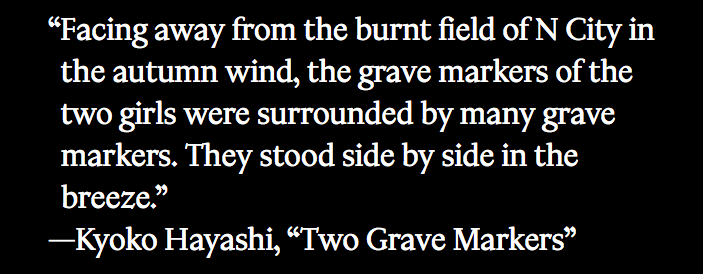
ID: selected quote from Two Grave Markers that reads: “Facing away from the burnt field of N City in the Autumn wind, the grave markers of the two girls were surrounded by many grave markers. They stood side by -side in the breeze.” – Kyoko Hayashi
Usually I have no desire to express a particular story. I constructed the score of this performance hoping that I did not avoid the pandemic but that I was not tied to it. The fact there are many dead there in the cemetery calmed me down.
I’ve made a lot of dances with themes of death. It is hard to know about death because by the time you’re dying, you are usually not capable of a clear recognition. I’ve always told any one, if you have a chance to attend death, either seeing the people before they die or being there as they die or attend a memorial or funeral, any way that is related to the death, it’s always a learning occasion. We don’t really live with death in our everyday lives. Death is usually concealed. How many people’s process of dying do we know about up close? We know more about living. But we all die. The pandemic is part of many years of dying.
AH: Yeah, I was thinking about that during your performance because my godfather died back in February, not because of Covid, but we never were able to have a memorial or funeral for him. We had to postpone everything and we never got to have that. And so going to the cemetery everyday to work with you, he was always in the back of my mind. And I’m sure everyone has somebody like that.
EO: That’s true, and I was aware. For many people, someone close to them has died in their life. It could be 10 years ago, but you still think about it. If that has not happened to someone yet, it will eventually. You can’t really come to the cemetery and not think about death or the people who have died. And that’s a good thing to think about.

